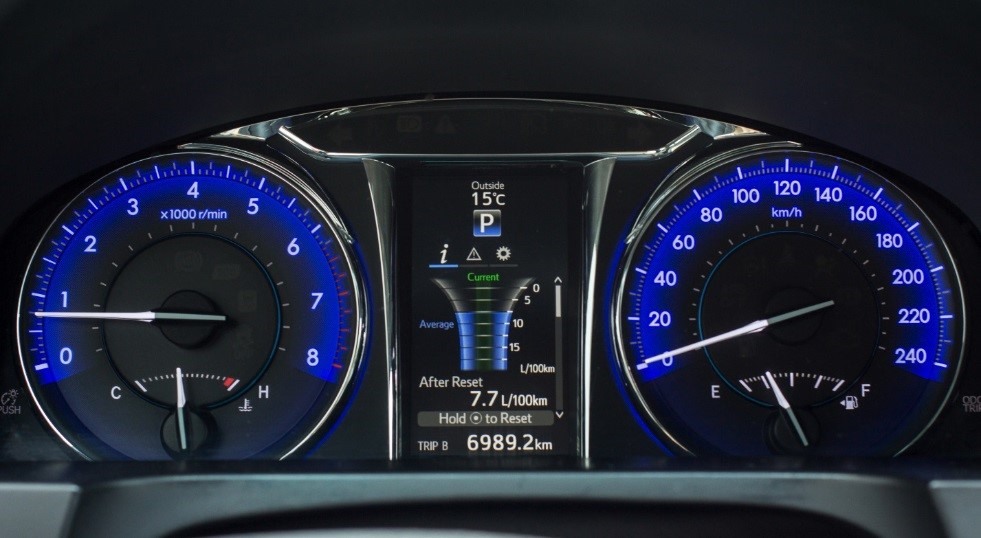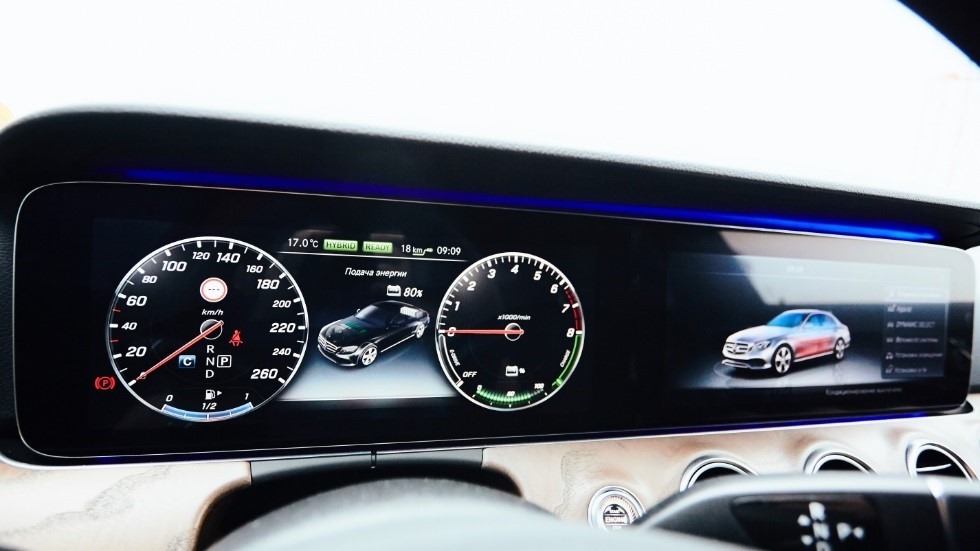SSZT787 february 2018
Although the automotive instrument cluster has evolved in the last few years, it has in many ways remained the same information center with which your grandparents would be familiar. Consider its origins as a panel with analog (mechanical) gauges showing vehicle speed, fuel level, engine temperature and oil pressure, as well as the odometer, as shown in Figure 1. This information, vital to the driver, remains in the instrument cluster of modern vehicles; however, new technological advances are leading to new capabilities.
The instrument cluster, while maintaining a traditional look, is now powered by a microcontroller (MCU) that reads vehicle status information from a Controller Area Network (CAN) bus. Drivers receive information in a familiar format, but stepper motors and the cluster’s MCU control the mechanical gauges and needles. Universally recognizable “tell tale” indicator lights and an audible chime provide additional information.
 Figure 1 An Analog Cluster Consisting
of Six Mechanical Gauges
Figure 1 An Analog Cluster Consisting
of Six Mechanical GaugesAs electronic technology advanced, the odometer was replaced with an alphanumeric display that highlighted functions and information such as fuel efficiency, outdoor temperatures and trip length, while maintaining the traditional information display through electromechanical gauges. This type of hybrid cluster with informational graphics support, shown in Figure 2, is inexpensive and relatively simple from an electronic standpoint. The MCU required for both the analog cluster and simpler hybrid cluster typically has integrated CAN interfaces and stepper motor drivers.
 Figure 2 A Cluster with a Simple
Digital Informational Display and Traditional Mechanical Gauges
Figure 2 A Cluster with a Simple
Digital Informational Display and Traditional Mechanical GaugesWhile this simple digital display represented a step forward for clusters, it is quickly giving way to more immersive liquid crystal displays (LCDs) that provide the kind of information shown in Figure 3. As these displays have grown in size, the graphics displayed on them require higher levels of processing. The same MCU still resides in the cluster and provides the data interface and stepper motor control, but a separate graphics processor or system-on-chip (SoC) creates video images and graphics capabilities, enabling drivers to select the information they want displayed and in what format. Higher-performance systems, typically found in premium vehicles, also integrate active video from external cameras or provide a driver monitoring feature.
 Figure 3 A Hybrid Cluster with Active
Graphics Support Gives Drivers More Options for Displaying Information
Figure 3 A Hybrid Cluster with Active
Graphics Support Gives Drivers More Options for Displaying InformationWhile the basic information presented in an instrument cluster remains the same, Tier-1 suppliers and original equipment manufacturers (OEMs) must change the design of their clusters to help differentiate the look of each instrument panel from one model to the next – as well as from their competitors’ vehicles. OEMs must also keep up with consumer trends because drivers expect new vehicles to have the latest technology and features. These two factors have led to the development of the reconfigurable digital cluster, which replaces the stepper motor gauges and indicator lights with a large LCD display that occupies the space once reserved for gauges. This evolution replaces the electromechanical parts of the cluster with virtual representations that can fool drivers into thinking that the needles and gauges are still there.
Large displays place additional performance requirements on the processor. In order to digitally animate a speedometer, the cluster video display needs fast frame rates in order to present an image representing a needle or a bar graph that appears to move smoothly. Of course, more power is required to sustain such a system.
The advantage for Tier-1 suppliers and OEMs is that a single, scalable electronics platform provides cluster differentiation between vehicles. Tailoring the visual content presentation lets drivers select the cluster arrangement they find most appealing or useful. This functionality can also be integrated with the rest of the infotainment system, with the cluster becoming a remote display system. Reconfigurable digital clusters like the one shown in Figure 4 are currently found primarily in premium vehicles, but as production volumes increase, production costs will decrease and this type of cluster will appear in more mid-market and economy vehicles.
 Figure 4 Example of a Reconfigurable
Digital Cluster
Figure 4 Example of a Reconfigurable
Digital ClusterAs you can probably tell after reading this post, vehicle instrument clusters have undergone tremendous changes in the last several years, as the analog cluster gives way to digital electronics. Along with it, increasing complexity has led to more design challenges. Whether your cluster design is analog, digital or a mix of both, TI’s technical resources will help reduce design time and system complexity.
Additional Resources
- Learn more about TI’s infotainment and cluster solutions.
- Read more about infotainment and cluster solutions in the blog post, “The road to today’s digital cockpit.”
- Read about the important role processors play in digital cockpits in the blog post, “Jacinto™ DRA automotive processors drive digital cockpit solutions.”
- Read more about TI’s Jacinto DRAx infotainment processors in the white paper, “Jump Start Upgrading Your Digital Cluster Design with Jacinto™ 6 Platform.”
- Accelerate your cluster power system with the Wide-Vin, 3A Buck 2-Layer Reference Design for Automotive Cluster with CISPR 25 Class 5 Compliance